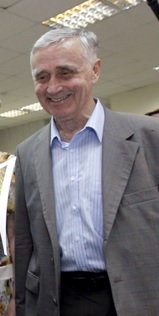Alexander Skrinsky on:
[Wikipedia]
[Google]
[Amazon]
 Alexander Nikolayevich Skrinsky (Скринский, Александр Николаевич) (born 15 January 1936) is a Russian nuclear physicist.
He was born in
Alexander Nikolayevich Skrinsky (Скринский, Александр Николаевич) (born 15 January 1936) is a Russian nuclear physicist.
He was born in
 Alexander Nikolayevich Skrinsky (Скринский, Александр Николаевич) (born 15 January 1936) is a Russian nuclear physicist.
He was born in
Alexander Nikolayevich Skrinsky (Скринский, Александр Николаевич) (born 15 January 1936) is a Russian nuclear physicist.
He was born in Orenburg
Orenburg (russian: Оренбу́рг, ), formerly known as Chkalov (1938–1957), is the administrative center of Orenburg Oblast, Russia. It lies on the Ural River, southeast of Moscow. Orenburg is also very close to the Kazakhstan-Russia bor ...
and was educated at the high school in the city of Gorky and then at the Lomonosov Moscow State University
M. V. Lomonosov Moscow State University (MSU; russian: Московский государственный университет имени М. В. Ломоносова) is a public research university in Moscow, Russia and the most prestigious ...
.
In 1957 he joined the laboratory of Gersh Budker, which was a part of the I. V. Kurchatov Institute of Atomic Energy (now the Kurchatov Institute). Since 1962, Skrinsky has been connected with the Budker Institute of Nuclear Physics
The Budker Institute of Nuclear Physics (BINP) is one of the major centres of advanced study of nuclear physics in Russia. It is located in the Siberian town Akademgorodok, on Academician Lavrentiev Avenue. The institute was founded by Gers ...
, where he was director from 1977 to 2015.
Skrinsky made a significant contribution to the development of the physics of accelerators and high-energy physics (in particular, he developed a method of colliding beams, he participated in the creation of new types of colliders in electron-electron, electron-positron and proton-antiproton beams).
In 1964, together with Budker, he developed the foundations of the method of colliding beams, on the basis of which the world's first VEP-1 collider was created at the Institute of Nuclear Physics of the Siberian Branch of the Academy of Sciences of the USSR for experiments in the physics of elementary particles and a series of studies on quantum electrodynamics was carried out. In 1966 an electron-positron collider VEPP-2 was constructed, experiments on which yielded valuable results on the physics of vector mesons and other hadrons. Later, the method of colliding beams became the basis of modern high-energy experimental physics; In particular, based on the technology of the colliding beams method, the Large Hadron Collider
The Large Hadron Collider (LHC) is the world's largest and highest-energy particle collider. It was built by the European Organization for Nuclear Research (CERN) between 1998 and 2008 in collaboration with over 10,000 scientists and hundred ...
was built.
On November 26, 1968 he was elected a corresponding member, and on December 24, 1970 a full member, of the Academy of Sciences of the USSR (since 1991 the Russian Academy of Sciences
The Russian Academy of Sciences (RAS; russian: Росси́йская акаде́мия нау́к (РАН) ''Rossíyskaya akadémiya naúk'') consists of the national academy of Russia; a network of scientific research institutes from across t ...
) in the Division of Nuclear Physics (High Energy Physics). He is also a full member of the American Physical Society
The American Physical Society (APS) is a not-for-profit membership organization of professionals in physics and related disciplines, comprising nearly fifty divisions, sections, and other units. Its mission is the advancement and diffusion of k ...
(1999) and a foreign member of the Royal Swedish Academy of Sciences
The Royal Swedish Academy of Sciences ( sv, Kungliga Vetenskapsakademien) is one of the Swedish Royal Academies, royal academies of Sweden. Founded on 2 June 1739, it is an independent, non-governmental scientific organization that takes special ...
(2000).
Skrinsky was a member of CERN
The European Organization for Nuclear Research, known as CERN (; ; ), is an intergovernmental organization that operates the largest particle physics laboratory in the world. Established in 1954, it is based in a northwestern suburb of Gene ...
's (European Organization for Nuclear Research) Scientific Policy Council between 1986 and 1992.
Honours and awards
*1967: Lenin Prize - for participation in the development of the method of colliding beams *1989: State Prize of the USSR *2001,2005: State Prizes of the Russian Federation *1991 The V.I. Veksler Prize of theRussian Academy of Sciences
The Russian Academy of Sciences (RAS; russian: Росси́йская акаде́мия нау́к (РАН) ''Rossíyskaya akadémiya naúk'') consists of the national academy of Russia; a network of scientific research institutes from across t ...
*1997 The Demidov Prize
The Demidov Prize (russian: Демидовская премия) is a national scientific prize in Russia awarded annually to the members of the Russian Academy of Sciences. Originally awarded from 1832 to 1866 in the Russian Empire, it was reviv ...
*2001 The Robert R. Wilson Prize The Robert R. Wilson Prize for Achievement in the Physics of Particle Accelerators is an annual prize established in 1987 by the American Physical Society (APS) to recognize and encourage outstanding achievement, ordinarily by one person but sometim ...
of the American Physical Society
The American Physical Society (APS) is a not-for-profit membership organization of professionals in physics and related disciplines, comprising nearly fifty divisions, sections, and other units. Its mission is the advancement and diffusion of k ...
*2002 The Karpinsky Prize of the Alfred Töpfer Foundation, Germany
References
* Article based on the equivalent article on Russian Wikipedia. {{DEFAULTSORT:Skrinsky, Alexander Nikolayevich 1936 births Living people Moscow State University alumni Russian physicists Full Members of the USSR Academy of Sciences Full Members of the Russian Academy of Sciences Lenin Prize winners People associated with CERN Scientists from Moscow Scientists from Novosibirsk